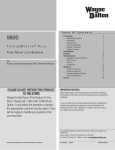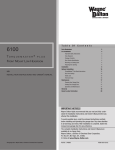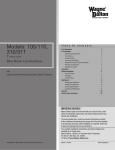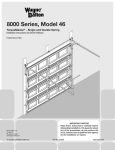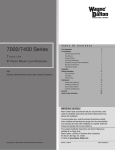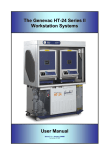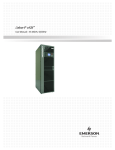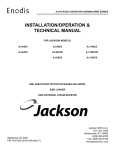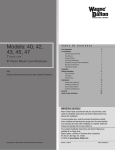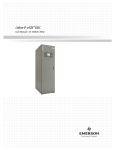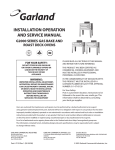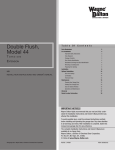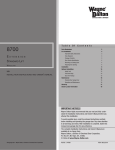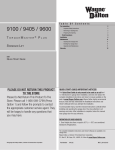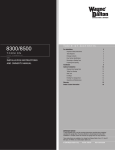Download Wayne-Dalton 9700 Garage Door Opener User Manual
Transcript
GARAGE DOORS & OPENERS 9700 To r q u e M a s t e r ® P l u s Front Mount Low Headroom MH installation instructions and owner’s manual Ta b l e O f C o n t e n t s Parts Breakdown Pre-Installation Important Safety Instructions Tools Required Package Contents Door Section Identification Removing an Existing Door Preparing the Opening Installation Optional Installation TorqueMaster® Plus Reset Instructions Door Arm Hookup Inside Lock Pull Down Rope Maintenance Cleaning Your Garage Door Painting Your Garage Door Operation and Maintenance Warranty Dealer Locator Information 2 3 3 3 3 4 4 4 6 14 14 14 14 15 16 16 16 16 17 18 IMPORTANT NOTICES! Wayne-Dalton highly recommends that you read and fully understand the Installation Instructions and Owner’s Manual before you attempt this installation. To avoid possible injury, read the enclosed instructions carefully before installing and operating the garage door. Pay close attention to all warnings and notes. After installation is complete, fasten this manual near garage door for easy reference. The complete Installation Instructions and Owner’s Manual are available at no charge from: Wayne-Dalton, a Division Of Overhead Door Corporation, P.O. Box 67, Mt. Hope, OH., 44660, Or Online At www.Wayne-Dalton.com ©Copyright 2011 Wayne-Dalton, a Division Of Overhead Door Corporation Part No. 343712 REV1 08/16/2011 Parts Breakdown NOTE: The illustrations shown on this page are general representations of the door parts. Each specific door models may have unique variations. J6. J6. J9. C1. A1. J1. A2. J2. F3. J8. J5. F2. F1. I2. G2. K2. H2. G1. E1. J3. H1. J7. C1. B2. A2. F1. F3. F2. Top of vertical track Top of vertical track E2. B1. B1. (Fully Adjustable Feature) 3rd hole set B1. E3. I4. A1. B2. D4. B1. D3. D2. D1. 2nd hole set I1. E4. B2. (Quick Install Feature) 3rd hole set 2nd hole set K1. Top hole C2. 1st hole set C1. I3. Middle hole Bottom hole J6. A. Flag Angles (As Required): A1. Fully Adjustable (F.A.) Flag Angles A2. Quick Install (Q.I.) Flag Angles B. Jamb Brackets (As Required): B1. Fully Adjustable (F.A.) Jamb Brackets B2. Quick Install (Q.I.) Jamb Brackets C. Track Rollers: C1. Short Stem Track Rollers C2. Long Stem Track Rollers D. Graduated End Hinges: D1. Single Graduated End Hinges (S.E.H.), Anti-Pinch D2. Single Graduated End Hinges (S.E.H.), Industry Standard D3. Double Graduated End Hinges (D.E.H.), Anti-Pinch D4. Double Graduated End Hinges (D.E.H.), Industry Standard E. Stacked Sections: E1. Top Section E2. Intermediate(s) Section E3. Lock Section E4. Bottom Section F. Top Fixture Assemblies (As Required): F1. Top Fixture Assemblies – For Models 9600/9400/9100/5140/5120 F2. Top Fixture Assemblies – For Model 9700 F3. Top Fixtures – For Model 9800 G. Strut(s) (As Required): 1st hole set Lower hole of hole/ slot pattern G1. Strut (U-shaped) G2. Strut (A-symmetrical) H. Drawbar Operator Bracket (For Trolley Operated Doors): H1. Drawbar Operator Bracket – For Models 9600/9400/9100/5140/5120 H2. Drawbar Operator Bracket – For Models 9700/9800 Tracks: I1. Left Hand Horizontal Track Assembly I2. Right Hand Horizontal Track Assembly I3. Left Hand Vertical Track I4. Right Hand Vertical Track J. TorqueMaster Plus® Spring Assembly: J1. Center Bracket Bushing Assembly J2. TorqueMaster® Spring Tube (Single Or Double Springs) J3. Left Hand End Bracket J4. Right Hand End Bracket (Disconnect Cable Guide) J5. Left Hand Cable Drum Assembly J6. Right Hand Cable Drum Assembly J7. Loose Winding Shaft (Single Spring Only) J8. Left Hand Drum Wrap (As Required) J9. Right Hand Drum Wrap (As Required) K. Rear Back Hangs: K1. Left Hand Rear Back Hang Assemblies K2. Right Hand Rear Back Hang Assemblies 2 Please Do Not Return This Product To The Store. Contact your local Wayne-Dalton dealer. To find your local Wayne-Dalton dealer, refer to your local yellow pages business listings or go to the Find a Dealer section online at www.Wayne-Dalton.com Pre-Installation Important Safety Instructions Tools Required Definition of key words used in this manual: • Power drill • Drill bits: 1/8”, 3/16”, 7/16” • Ratchet wrench • Socket driver: 7/16” • Sockets: 7/16”, 1/2”, 9/16”, 5/8” • Socket extension: 3” WARNING Indicates a potentially hazardous situation which; if not avoided, could result in severe or fatal injury. Caution: Property damage or injury can result from failure to follow instructions. Important: Required step for safe and proper door operation. Note: Information assuring proper installation of the door. READ THESE INSTRUCTIONS CAREFULLY BEFORE ATTEMPTING INSTALLATION. IF IN QUESTION ABOUT ANY OF THE PROCEDURES, DO NOT PERFORM THE WORK. INSTEAD, HAVE A TRAINED DOOR SYSTEMS TECHNICIAN DO THE INSTALLATION OR REPAIRS. • Phillips head screwdriver • Flat tip screwdriver • Pliers/Wire cutters • Needle nose pliers • Locking Pliers • (2) Vice clamps • Wrenches: 7/16”, 1/2”, 9/16”, 5/8” • Hammer • Tape measure • Step Ladder • Level • Pencil • Leather gloves • Safety glasses Package Contents 1. 2. 3. READ AND FOLLOW ALL INSTALLATION INSTRUCTIONS. Wear protective gloves during installation to avoid possible cuts from sharp metal edges. It is always recommended to wear eye protection when using tools, otherwise eye injury could result. 4. Avoid installing your new door on windy days. Door could fall during the installation causing severe or fatal injury. 5. Doors 12’-0” wide and over should be installed by two persons, to avoid possible injury. 6. Operate door only when it is properly adjusted and free from obstructions. 7. If a door becomes hard to operate, inoperative or is damaged, immediately have necessary adjustments and/ or repairs made by a trained door system technician using proper tools and instructions. 8. DO NOT stand or walk under a moving door, or permit anybody to stand or walk under an electrically operated door. 9. DO NOT place fingers or hands into open section joints when closing a door. Use lift handles/ gripping points when operating door manually. 10. DO NOT permit children to operate garage door or door controls. Severe or fatal injury could result should the child become entrapped between the door and the floor. 11. Due to constant extreme spring tension, do not attempt any adjustment, repair or alteration to any part of the door, especially to springs, spring brackets, bottom corner brackets, fasteners, counterbalance lift cables or supports. To avoid possible severe or fatal injury, have any such work performed by a trained door systems technician using proper tools and instructions. 12. On electrically operated doors, pull down ropes must be removed and locks must be removed or made inoperative in the open (unlocked) position. 13. Top section of door may need to be reinforced when attaching an electric opener. Check door and/ or opener manufacturer’s instructions. 14. Visually inspect door and hardware monthly for worn and or broken parts. Check to ensure door operates freely. 15. Test electric opener’s safety features monthly, following opener manufacturer’s instructions. 16. NEVER hang tools, bicycles, hoses, clothing or anything else from horizontal tracks. Track systems are not intended or designed to support extra weight. 17. This door may not meet the building code wind load requirements in your area. For your safety, you will need to check with your local building official for wind load code requirements and building permit information. After installation is complete, fasten this manual near the garage door. Important: Stainless steel or pt2000 coated lag screws must be used when installing center bearing brackets, end brackets, jamb brackets, drawbar operator mounting/ support brackets and disconnect brackets on treated lumber (preservative-treated). Stainless steel or pt2000 lag screws are not necessary when installing products on un-treated lumber. Note: It is recommended that 5/16” lag screws are pilot drilled using a 3/16” drill bit, prior to fastening. Important: When installing 5/16” lag screws using an electric drill/ driver, the drill/ drivers clutch must be set to deliver no more than 200 in-lbs of torque. Fastener failure could occur at higher settings. Note: Depending on the door model, some parts listed will not be supplied if not required. Rear Back Hangs may not be included with your door. Door sections (as required) TorqueMaster® spring tube Quick Install flag angles RH/LH (as required) Fully Adjustable flag angles RH/LH (as required) Vertical tracks RH/LH Horizontal tracks RH/LH ED SIDE VIEW ENGAG t Pawl VIEW Ratche EATH NDERN Quick install jamb Fully Adjustable jamb brackets (as required) brackets (as required) (2) Top fixtures Pull down rope (if included) Drawbar operator bracket (if included) Track rollers (as required) Center bracket End brackets RH/LH bushing assembly Cable drum Drum wraps assemblies RH/LH RH/LH (as required) Weatherstrips & nails (If included) Loose winding shaft (single spring only) WARNING Prior to winding or making adjustments to the springs, ensure you’re winding in the proper direction as stated in the Installation Instructions. Otherwise, the spring fittings may release from spring if not wound in the proper direction and could result in severe or fatal injury. (2) 3/8”- 16 Hex nuts Stud Plate (as required) (2) 5/16”-18 Hex nuts (2) 3/8”-16 x 3/4” Truss head bolts Important: Right and left hand is always determined from inside the building looking out 1/4”- 20 Flanged hex nuts (as required) 3 (2) 5/16” Washers Please Do Not Return This Product To The Store. Contact your local Wayne-Dalton dealer. To find your local Wayne-Dalton dealer, refer to your local yellow pages business listings or go to the Find a Dealer section online at www.Wayne-Dalton.com 1/4”-20 x 11/16” Self drilling screws (as required) WARNING 5/16” x 1 5/8” Hex head lag screws (as required) 1/4”-20 x 9/16” Track bolts (as required) A powerful spring releasing its energy suddenly can cause severe or fatal injury. To avoid injury, have a trained door systems technician, using proper tools and instructions, release the spring tension. 1/4”-14 x 5/8” Self tapping screws (as required) For detailed information see supplemental instructions “Removing an Existing Door/ Preparing the Opening”. These instructions are not supplied with the door, but are available at no charge from Wayne-Dalton, A Division Of Overhead Door Corporation, P.O. Box 67, Mt. Hope, OH., 44660, or at www.Wayne-Dalton.com. (2) 5/16”-18 x 3/4” Carriage bolts Cotter pin Preparing the Opening IMPORTANT: If you just removed your existing door or you are installing a new door, complete all steps in preparing the opening. To ensure secure mounting of track brackets, side and center brackets, or steel angles to new or retro-fit construction, it is recommended to follow the procedures outlined in DASMA technical data sheets #156, #161 and #164 at www.dasma.com. The inside perimeter of your garage door opening should be framed with wood jamb and header material. The jambs and header must be securely fastened to sound framing members. It is recommended that 2” x 6” lumber be used. The jambs must be plumb and the header level. The jambs should extend a minimum of 12” (305 mm) above the top of the opening for TorqueMaster® counterbalance systems. For low headroom applications, the jambs should extend to the ceiling height. Minimum side clearance required, from the opening to the wall, is 3-1/2” (89 mm). Important: Closely inspect jambs, header and mounting surface. Any wood found not to be sound, must be replaced. For TorqueMaster® counterbalance systems, a suitable mounting surface (2” x 6”) must be firmly attached to the wall, above the header at the center of the opening. Note: Drill a 3/16” pilot hole in the mounting surface to avoid splitting the lumber. Do not attach the mounting surface with nails. Weatherstrips (may not be included): Depending on the size of your door, you may have to cut or trim the weatherstrips (if necessary) to properly fit into the header and jambs. Note: If nailing product at 40°F or below, pre-drilling is required. Note: Do not permanently attach weatherstrips to the header and jambs at this time. For Quick Install track: For the header, align the weatherstrip with the inside edge of the header and temporarily secure it to the header with equally spaced nails. Starting at either side of the jamb, fit the weatherstrip up tight against the temporarily attached weatherstrip in the header and flush with the inside edge of the jamb. Temporarily secure the weatherstrip with equally spaced nails. Repeat for other side. This will keep the bottom section from falling out of the opening during installation. Equally space nails approximately 12” to 18” apart. For Fully Adjustable track: For the header, align the weatherstrip 1/8” to 1/4” inside the header edge, and temporarily secure it to the header with equally spaced nails. Starting at either side of the jamb, fit the weatherstrip up tight against the temporarily attached weatherstrip in the header and 1/8” to 1/4” inside the jamb edge. Temporarily secure the weatherstrip with equally spaced nails. Repeat for other side. This will keep the bottom section from falling out of the opening during installation. Equally space nails approximately 12” to 18” apart. Headroom requirement: Headroom is defined as the space needed above the top of the door for tracks, springs, etc. to allow the door to open properly. If the door is to be motor operated, 2-1/2” (64 mm) of additional headroom is required. Note: 6” low headroom conversion kit is available for 12” radius only. Contact your local Wayne-Dalton dealer. Backroom requirement: Backroom is defined as the distance needed from the opening back into the garage to allow the door to open fully. Backroom Requirements 5/16” x 1-1/4” Clevis pin Door Section Identification Graduated end and center hinges are always pre-attached at the top of each section (except top section) and the graduated end hinges are stamped for identification, #1, #2, #3, and #4 (#4 only on five section doors). The stamp identifies the stacking sequence of the section. The sequence is always determined by #1 being the bottom section to #3 or #4 being the highest intermediate section. If the stamp on the graduated end hinge is illegible, refer to the section side view illustration. The section side view illustration shows the graduated end hinge profile of all sections, and can also be used to identify each section. The BOTTOM SECTION can be identified by #1 graduated end hinges, the factory attached bottom astragal, the factory attached bottom corner brackets and by the bottom corner bracket warning labels on each end stile. The LOCK SECTION can be identified by #2 graduated end hinges on a 4 section high door and by #3 graduated end hinges on a 3 section high door. Also, on a 3 section door, the lock section will come with a warning label attached to the right or left endstile. The INTERMEDIATE SECTION can be identified by #3 graduated end hinges (Only on a 4 section high door). The section will have a warning label attached to either the right or left hand end stile. Note: #4 graduated end hinges are used on the fourth section of five section doors. The TOP SECTION can be identified with no pre-installed graduated end or center hinges. Warning label Top section 1-3/8” #3 Warning labels (Only on a 4 Section High Door) Intermediate section 1-1/8” #2 Warning labels (Only on a 3 Section High Door) Lock section #2 Graduated end hinge 7/8” #1 Bottom corner bracket warning labels Bottom section Bottom weather seal Typical graduated end hinge stamping location #3 Graduated end hinge #1 Graduated end hinge Bottom corner bracket Bottom weather seal Door Height Track Manual Lift Motor Operated 6’0” to 7’0” 6” Low Headroom 102” (2591 mm) 125” (3175 mm) 7’1” to 8’0” 6” Low Headroom 114” (2896 mm) 137” (3480 mm) Headroom Requirements Section side view illustration Track Type Space Needed 6” Low Headroom 9” (229 mm) Removing an Existing Door Important: Counterbalance spring tension must always be released before any attempt is made to start removing an existing door. 4 Please Do Not Return This Product To The Store. Contact your local Wayne-Dalton dealer. To find your local Wayne-Dalton dealer, refer to your local yellow pages business listings or go to the Find a Dealer section online at www.Wayne-Dalton.com Suitable mounting surface 2”x 6” lumber minimum Headroom Min. Side room Clearance is 3 1/2” Header board 2”x 6” lumber preferred der Min. Side room Clearance is 3 1/2” ea el h Lev Bac kro Nail om s trip Finished ers Door ath e W Height Plumb jambs ed ish Fin width r Doo bs Jam Jamb Quick Install track Weatherstrips Weatherstrips Jamb Fully Adjustable track 1/8” to 1/4” 5 Please Do Not Return This Product To The Store. Contact your local Wayne-Dalton dealer. To find your local Wayne-Dalton dealer, refer to your local yellow pages business listings or go to the Find a Dealer section online at www.Wayne-Dalton.com Vertical track Installation 1st hole set Before installing your door, be certain that you have read and followed all of the instructions covered in the pre-installation section of this manual. Failure to do so may result in an improperly installed door. NOTE: Reference TDS 160 for general garage door terminology at www.dasma.com. 1 Tools: None Jamb Bracket Schedule 57.75” (1467mm) 5 M 8 T - - 6’6” 63.50” (1613mm) 3 B 6 M - - 6’8” 65.50” (1664mm) 3 B 6 M - - 6’10” 67.00” (1702mm) 3 B 6 M - - 7’0” 69.50” (1765mm) 3 B 6 M - - 7’3” 72.50” (1842mm) 3 B 7 T 8 T 7’6” 75.50” (1918mm) 3 B 7 T 8 T 7’9” 78.50” (1994mm) 3 B 7 T 8 T 8’0” (4 Sec) 81.50” (2070mm) 3 B 7 T 8 T Tools: None 3 4 Fully Adjustable Jamb Brackets Tools: None Note: If you have Quick Install jamb brackets, skip this step. Note: If you have riveted track, skip this step. Note: The bottom jamb bracket is always the shortest bracket, while the center jamb bracket is the next tallest. If three jamb brackets per side are included with your door, you will have received a top jamb bracket, which is the tallest. To attach the bottom jamb bracket, locate lower hole of the hole/ slot pattern of the 1st hole set on the vertical track. Align the slot in the jamb bracket with the lower hole of the hole/ slot pattern. Secure jamb bracket using (1) 1/4”-20 x 9/16” track bolt and (1) 1/4”-20 flange hex nut. Repeat for other side. Place the center jamb bracket over the lower hole of the hole/ slot pattern that is centered between the bottom jamb bracket and flag angle of the 2nd hole set. Secure jamb bracket using (1) 1/4”-20 x 9/16” track bolt and (1) 1/4”-20 flange hex nut. Repeat for other side. If a top jamb bracket was included, secure it to vertical track using the lower hole of the hole/ slot pattern in the 3rd hole set and (1) 1/4”-20 x 9/16” track bolt and (1) 1/4”-20 flange hex nut. Repeat for other side. Vertical track Top of track Stud plate JAMB BKT POSITION JAMB BKT POSITION JAMB BKT POSITION B= BOTTOM HOLE, M= MIDDLE HOLE, T= TOP HOLE Flag angle 1/4”-20 Flange hex nuts Fully Adjustable vertical track 3RD SET 6’0” Fully Adjustable Flag Angles Quick Install vertical track 2ND SET TRACK LENGTH Lower Quick Install tab Quick Install feature Note: If you have Quick Install flag angles, skip this step. Note: If you have riveted track, skip this step. Note: Flag angles are right and left handed. If you have Quick Install vertical tracks, hand tighten the left hand flag angle to the left hand vertical track using (1) stud plate and (2) 1/4” – 20 flange hex nuts. Repeat for the other side. If you have Fully Adjustable vertical tracks, hand tighten the left hand flag angle to the left hand vertical track using (2) 1/4”-20 x 9/16” track bolts and (2) 1/4”-20 flange hex nuts. Repeat for other side. Flange nuts will be secured after flag angle spacing is completed in step, Top Section. 1ST SET DOOR HEIGHT 1/4 Turn Flag angle 1/4”-20 Flange hex nuts Mounting flange Q.I. jamb bracket Flag angle 2 Jamb bracket in place Q.I. tab Note: If you have Fully Adjustable flag angles, skip this step. Note: If you have riveted track, skip this step. Note: Flag angles are right and left handed. Place the lower Quick Install tab of the left hand flag angle in the Quick Install feature of the left hand vertical track. Give the flag angle 1/4 turn to lock in place. Repeat for other side. 3rd hole set Bottom hole Middle hole Top hole Quick Install Flag Angles Vertical track 2nd hole set Top of track 1/4”- 20 x 9/16” Track bolts Quick Install Jamb Brackets Tools: None 1st hole set Note: If you have Fully Adjustable jamb brackets, skip this step. Note: If you have riveted track, skip this step. Measure the length of the vertical tracks. Using the jamb bracket schedule, determine the placement of the jamb brackets for your door height and track length. To install the jamb brackets, align the Quick Install tab on the Quick Install jamb bracket with the Quick Install feature in the vertical track and turn the bracket perpendicular to the track so the mounting flange is toward the back (flat) leg of the track. Repeat for other side. Lower hole of hole/ slot pattern 2nd hole set 3rd hole set 1/4”- 20 Flange hex nut F.A. jamb bracket 6 Please Do Not Return This Product To The Store. Contact your local Wayne-Dalton dealer. To find your local Wayne-Dalton dealer, refer to your local yellow pages business listings or go to the Find a Dealer section online at www.Wayne-Dalton.com 1/4”- 20 x 9/16” Track bolt Jamb bracket in place 5 Cable Drum Assemblies and Track Rollers Tools: None NOTE: Refer to door section identification, located in the pre-installation section of this manual or refer to Parts Breakdown on page 2. NOTE: Cable drum assemblies are marked right and left hand. Weather seal WARNING Failure to ensure tight fit of cable loop over milford pin could result in counterbalance lift cable coming off the pin, allowing the door to fall, possibly resulting in severe or fatal injury. Level Uncoil the counterbalance lift cables from the cable drum assemblies, making sure you place the left hand cable loop on the left hand milford pin of the bottom corner bracket and the right hand cable loop on the right hand milford pin of the bottom corner bracket. NOTE: Check to ensure cable loops fits tightly over the milford pins. Insert a short stem track roller into the bottom corner brackets and another into the #1 graduated end hinges at the top of the bottom section. Note: Larger doors will use long stem track rollers with double graduated end hinges. NOTE: Verify bottom weather seal is aligned with bottom section. If there is more than 1/2” excess weather seal on either side, trim weather seal even with bottom section. Counterbalance lift cable Long stem track roller Counterbalance lift cable Bottom corner bracket warning label 7 Vertical Tracks Tools: Power Drill, 3/16” Drill bit, 7/16” Socket driver, Tape measure, IMPORTANT: If your door is to be installed prior to a finishing construction of the building’s floor, the vertical tracks and the door bottom section assembly should be installed such that when the floor is constructed, no door or track parts are trapped in the floor construction. Important: The tops of the vertical tracks must be level from side to side. If the bottom section was shimmed to level it, the vertical track on the shimmed side must be raised the height of the shim. Position the left hand vertical track assembly over the track rollers of the bottom section. Drill 3/16” pilot holes into the door jamb for the lag screws. Loosely fasten jamb brackets and flag angle to the jamb using 5/16” x 1-5/8” lag screws. Tighten lag screws, securing the bottom jamb bracket to jamb, maintain 3/8” to 5/8” spacing, between the bottom section and vertical track. Repeat same process for other side. Double graduated end hinge (Hinge tube) Bottom section Cable loop Cable loop 6 Short stem track roller Bottom section Wooden shims (If necessary) #1 Single graduated end hinge (Hinge tube) Left hand cable drum assembly Milford pin Bottom section Milford pin Bottom corner bracket Short stem track roller Bottom corner bracket Bottom weather seal Flag angle Vertical track assembly Bottom Section Tools: Level, Wooden shims (if necessary) 5/16” x 1-5/8” Lag screws Jamb bracket 12R FA 15R FA 12R QI 15R QI Flag angle lag screw locations Center the bottom section in the door opening. Level the section using wooden shims (if necessary) under the bottom section. Bottom section 3/8” to 5/8” Spacing Track rollers Bottom section Vertical track Floor 8 Track roller Stacking Sections Tools: Power drill,7/16” Socket driver Note: The sections can be identified by the graduation of the factory installed end hinges. The smallest graduated end hinge on section should be stacked on top of the bottom section, with each graduated end hinge increasing as the sections are stacked, see Parts Breakdown on page 2. Note: Make sure graduated end and center hinges are flipped down, when stacking another section on top. Note: Larger doors will use long stem track rollers with double graduated end hinges. Place track rollers into graduated end hinges of remaining sections. With assistance, lift second section and guide the track rollers into the vertical tracks. Lower section until it is seated against bottom section. Align vertical marks in the upper alignment 7 Please Do Not Return This Product To The Store. Contact your local Wayne-Dalton dealer. To find your local Wayne-Dalton dealer, refer to your local yellow pages business listings or go to the Find a Dealer section online at www.Wayne-Dalton.com allowing the drawbar operator bracket to slide between the section and the strut. NOTE: For retro fit applications, the drawbar operator bracket must be aligned with an existing drawbar operator. Locate the center of the top section and slide drawbar operator bracket under strut till the drawbar operator bracket is seated against the strut flange. NOTE: Prior to fastening drawbar operator bracket to top section, ensure the top edge of drawbar operator bracket is aligned with the top edge of the section, as shown. Attach the drawbar operator bracket using (6) 1/4” – 20 x 5/8” self drilling screws (as shown). Finish re-attaching the strut using the self tapping screws removed previously. sticker, with the lower alignment sticker on right hand side, on the back of door. Keep sections aligned and fasten center hinge(s) first; then end hinges last using 1/4”-14 x 5/8” self tapping screws. NOTE: To prevent center hinge leaf(s) from rotating, first secure the top middle hole of the center hinge leaf with one 1/4” – 14 x 5/8” self-tapping screw then secure the other two holes. NOTE: Larger doors with double graduated end hinges, fasten both hinges to connect the sections using 1/4” - 14 x 5/8” self-tapping screws. Repeat same process for other sections, except top section. Important: Push & hold the hinge leafs securely against the sections while securing with 1/4”-14 x 5/8” self tapping screws. There should be no gap between the hinge leafs and the sections. Top section Top section Drawbar operator bracket Alignment sticker Strut Strut P/N # 327985 NEW 9-04-06 Lock section 1/4” - 20 x 7/8” Self-drilling screws Left double graduated end hinge with long stem track roller P/N # 327985 NEW 9-04-06 Vertical tracks Alignment sticker Right double graduated end hinge with long stem track roller 1/4”-14 x 5/8” Self tapping screw locations Secure top middle hole first 11 Center Right graduated end hinge Left graduated end hinge hinge(s) with short stem track roller with short stem track roller 9 (6) 1/4” - 20 x 5/8” Self-drilling screws Drawbar operator bracket in place under strut Tools: Hammer, Power drill, 7/16” Socket driver, 7/16” Socket, 7/16” Place the top section in the opening. Temporarily secure the top section by driving a nail into the header near the center of the door and bending it over the top section. Now, flip up the graduated end hinge and center hinge leaves, hold tight against section, and fasten center hinges first and end hinges last (refer to step, Stacking Sections). Vertical track alignment is critical. Position flag angle between 1-11/16” (43 mm) to 1-3/4” (44 mm) from the edge of the door; tighten the bottom lag screw. Flag angles must be parallel to the door sections. Repeat same process for other side. Important: the dimension between the flag angles must be door width plus 3-3/8” (86mm) to 3-1/2” (89 mm) for smooth, safe door operation. For Quick Install Track: Complete the vertical track installation by securing the jamb bracket(s) and tightening the other lag screws. Repeat for other side. For Fully Adjustable track: Complete the vertical track installation by securing the jamb bracket(s) and tightening the other lag screws. Push the vertical track against the track rollers so that the track rollers are touching the deepest part of the curved side of the track; tighten all the track bolts and nuts. Repeat for other side. Top Fixtures Tools: Power drill, 7/16” Socket driver NOTE: The top fixtures come pre-assembled from the factory. Starting on the left hand side, locate the edge of the top section and seat the top fixture on male part of the top section, as shown. 1. Attach one 1/4” - 20 x 11/16” self-drilling screw to the top fixture assembly. 2. Attach two 1/4” - 20 x 11/16” self-drilling screws to the top fixture assembly. 3. Attach two #12 x 1/2” phillips head screws on the opposite side of top fixture assembly. Insert short stem track roller into top fixture slide. Repeat for left hand side. Short stem track roller Top Section 3. (2) 12# x 1/2” Phillips head screws Door width + 3-3/8” to 3-1/2” Top fixture slide Flag angle Top section Top fixture assembly Nail Top section 2. (2) 1/4”- 20 x 11/16” Self-drilling screws 10 1-11/16” to 1-3/4” 1. (1) 1/4”- 20 x 11/16” Self-drilling screw Drawbar Operator Bracket Flag angle Tools: Power drill, 7/16” Socket driver Note: If you’re installing a drawbar operator, the drawbar operator bracket must be mounted and secured prior to installing top section. Important: when connecting a drawbar operator type garage door opener to this door, a Wayne-Dalton operator/ drawbar operator bracket must be securely attached to the top section of the door, along with any strut provided with the door. The installation of the drawbar operator must be according to manufacturer’s instructions and force settings must be adjusted properly. Remove, but retain (4-6) 1/4”-20 x 7/8” self drilling screws from the center of the strut, Top section Vertical track against track rollers 8 Please Do Not Return This Product To The Store. Contact your local Wayne-Dalton dealer. To find your local Wayne-Dalton dealer, refer to your local yellow pages business listings or go to the Find a Dealer section online at www.Wayne-Dalton.com 12 Horizontal Tracks/Q.I Flag Angles Note: If you have Quick Install flag angles, complete this step. To install horizontal track, place the top rail end over the top track roller of the top section. Align key slot of the bottom rail end of horizontal track with the Quick Install tab of the flag angle. Push curved portion of horizontal track down to lock in place. Tools: 7/16” Wrench, Step ladder Adjusting top fixture slide: With horizontal tracks installed, you can now adjust the top fixtures. Vertically align the top section of the door with the lower sections. Once aligned, position the top fixture slide, out against the horizontal track. Maintaining the slide’s position, tighten the (2) 1/4”-20 flange hex nuts to secure the top fixture slide to the top fixture base. Repeat for other side. Reversing the top fixture slide (if needed): NOTE: Depending on your application, you may need to reverse the top fixture slide for more adjustment, if needed, prior to securing it to the top fixture base. Remove the top fixture slide by removing the two 1/4” - 20 x 5/8” carriage bolts, two retention washers and two 1/4” - 20 flanged hex nuts. Flip the top fixture slide in the opposite direction. Loosely fasten the top fixture slide to the bracket using two 1/4” - 20 x 5/8” carriage bolts, two retention washers and two 1/4” - 20 flanged hex nuts, as shown. NOTE: The retention washers must be fully seated against the top fixture base to ensure the anti-twist feature on the top fixture slide engages in the slotted hole in the top bracket fixture. Now follow the instructions at the top of this step “Adjusting top fixture slide: Short stem track roller WARNING Do not raise door until horizontal tracks are secured at rear, as outlined in Step, Rear Back Hangs, or door could fall from overhead position causing severe or fatal injury. Level the horizontal track assembly and bolt the top rail of the horizontal track to the encountered slot in the flag angle using (1) 1/4”-20 x 9/16” track bolt, (1) 1/4”-20 flange hex nut and (1) 5/16 washer. Repeat for other side. Remove the nail that was temporarily holding the top section in place, installed in step, Top Section. Important: Failure to remove nail before attempting to raise door could cause permanent damage to top section. Note: If an idrive® opener will be installed, position horizontal tracks slightly above level. Flagangle Adjusting Top Fixtures 14 Tools: Ratchet wrench, 9/16” Socket, 9/16” Wrench, level, Step ladder (2) 1/4” - 20 Flange hex nuts Low headroom horizontal track 1/4”-20 x 9/16” Track bolt Top fixture slide Flag angle Bottom rail of horizontal track Quick Install tab Top fixture assembly Quick Install tab in place Washer Top rail of horizontal track 1/4”-20 Flange hex nut Tracks flush Key slot Vertical track Vertical track 13 Top section Top fixture slide (2) Retention washers (2) 1/4” - 20 Flange hex nuts Top fixture slide reversed Horizontal Tracks/F.A. Flag Angles Anti-twist feature Slotted hole of top fixture base (2) 1/4” - 20 x 5/8” Carriage bolts Tools: Ratchet wrench, 7/16” Socket, 9/16” Socket, 9/16” Wrench, Note: If you have Fully Adjustable flag angles, complete this step. To install horizontal track, place the top rail end over the top track roller of the top section. Align the bottom rail end of the horizontal track with the top of the vertical track. If you have Quick Install horizontal track, tighten the bottom rail of the horizontal track to the flag angle with (1) stud plate and (2) 1/4”-20 flange hex nuts. If you have Universal horizontal track, tighten the bottom rail of the horizontal track to the flag angle with (2) 1/4”-20 x 9/16” track bolts and (2) 1/4”-20 flange hex nuts. 15 TorqueMaster® Spring Tube Tools: None TorqueMaster® springs come lubricated and pre-assembled inside the TorqueMaster® spring tube. To prepare for install, lay the spring tube assembly on the floor, inside garage, in front of the door, and with the labeled end to the left. WARNING Do not raise door until horizontal tracks are secured at rear, as outlined in step, Rear Back Hangs, or door could fall from overhead position causing severe or fatal injury. Level the horizontal track assembly and bolt the top rail of the horizontal track to the encountered slot in the flag angle using (1) 1/4”-20 x 9/16” track bolt, (1) 1/4”-20 flange hex nut and (1) 5/16 washer. Repeat for other side. Remove the nail that was temporarily holding the top section in place, installed in step, Top Section. Important: Failure to remove nail before attempting to raise door could cause permanent damage to top section. Note: If an idrive® opener will be installed, position horizontal tracks slightly above level. Bottom rail Quick Install Horizontal track 1/4”-20 Flange hex nuts Flag angle upper slot Vertical track Stud plate Bottom rail Fully Adjustable Horizontal track Flagangle 1/4”-20 x 9/16” Track bolt TorqueMaster® spring tube Label 1/4”-20 Flange hex nuts Flag angle upper slot Vertical track 1/4”-20 x 9/16” Track bolts Washer Top rail of horizontal track 1/4”-20 Flange hex nut 16 Center Bracket Bushing Assembly Tools: None Note: If you are installing the idrive® opener with your garage door, skip this step and go to your idrive® Installation Instructions and Owner’s Manual. After completing the steps up to and including, Drum Wrap Installation of your idrive® Installation Instructions and Owner’s Manual continue with Step, Rear Back Hangs, of this door Installation Instructions and 9 Please Do Not Return This Product To The Store. Contact your local Wayne-Dalton dealer. To find your local Wayne-Dalton dealer, refer to your local yellow pages business listings or go to the Find a Dealer section online at www.Wayne-Dalton.com Owner’s Manual. Note: If you are not installing the idrive® opener on your garage door, you must install the center bracket bushing assembly. Follow these instructions for non-idrive® operated garage doors. Being cam shaped, the center bushing only fits one way. Slide the center bracket bushing assembly towards the center of the TorqueMaster® spring tube, from the right side, as shown. Winding shaft Cam peak straight Cable drum Counterbalance lift cable 1-1/2 wraps Grooves Winding shaft 5” Center bracket TorqueMaster spring tube assembly ® TorqueMaster® spring tube Flag angle Round notch Splines Center bushing Right cable drum Cam peak Loose winding shaft 19 Center bracket bushing assembly 17 Drum Wraps End Brackets Tools: Power drill, 7/16” Socket driver, 1/2” Wrench, Step ladder IMPORTANT: Warning tags must be securely attached to both end brackets. End brackets are right and left hand. You can identify the right hand end bracket by the disconnect cable guide hole, located at the top of the end bracket. Beginning with the right hand side, slide the end bracket onto the winding shaft so that the splines in the ratchet wheel fit onto the winding shaft grooves. Attach the end bracket to the flag angle using (1) 5/16”-18 x 3/4” carriage bolt, (1) 5/16” washer and (1) 5/16”-18 hex nut. Then secure the end bracket to the jamb using (1) 5/16” x 1-5/8” lag screw. Repeat same process for left hand end bracket. NOTE: If ratchet wheel falls out of end bracket, refer to illustration for proper insertion orientation. NOTE: On single spring applications, no ratchet wheel is required on the left hand side. Tools: None NOTE: If you don’t have drum wraps, then skip this step. Refer to Package Contents / Parts Breakdown, to determine if you have drum wraps. Drum wraps are marked right and left hand. Beginning with the left hand side, slide the left hand drum wrap onto the TorqueMaster® spring tube. Repeat for the right hand side. The drum wrap will be secured later, in Step, Securing Drum Wraps. Right hand drum wrap Left hand drum wrap Grooves Winding shaft Splines Disconnect cable guide hole Flag angle TorqueMaster® spring tube Label 18 Warning tag Cable Drum Assemblies Tools: Tape measure, Step ladder Right hand end bracket Shake the TorqueMaster spring tube assembly gently to extend the winding shafts out about 5” on each side. For single spring applications, there will be no left hand spring in the TorqueMaster® spring tube assembly. Lift the TorqueMaster® spring tube assembly and rest it on top of the flag angles. NOTE: Cable drum assemblies are marked right and left hand. Cable drums and TorqueMaster® spring tube assembly is cam shaped to fit together only one way. Starting on the right hand side, pre-wrap the cable drum with the counterbalance lift cable 1-1/2 wraps, as shown. Position the TorqueMaster® spring tube assembly so the cam peak is pointing straight up. Slide the cable drum over the winding shaft until the cable drum seats against the TorqueMaster® spring tube assembly. The winding shaft must extend past the cable drum far enough to expose the splines and the grooves. Align the winding shaft grooves with the round notch in the flag angle. For double spring applications: Repeat for left hand side. For single spring applications: Pre-wrap the left hand cable drum with the counterbalance lift cable 1-1/2 wraps and insert the loose winding shaft into the cable drum, prior to sliding the cable drum over the TorqueMaster® spring tube assembly. NOTE: On single spring applications, take care in handling the loose winding shaft (left hand side), so that it does not slide back into the TorqueMaster® spring tube assembly. ® 5/16” Hex nut Right hand end bracket Ratchet wheel (teeth pointing upwards) 5/16” x 1-5/8” Lag screw 5/16” -18 x 3/4” Carriage bolt Flag angle Black tooth 20 5/16” Washer Securing Center Bracket Bushing Assembly Tools: Power drill, 3/16” Drill bit, 7/16” Socket driver, Step ladder, Level IMPORTANT: TorqueMaster® spring tube must be level before securing center bracket bushing assembly to header. To locate the center bracket bushing assembly, mark the header halfway between the flag angles and level the TorqueMaster® spring tube. Drill 3/16” pilot holes into header for the lag screws. Fasten the center bracket bushing assembly to the header using (2) 5/16” x 1-5/8” lag screws. 10 Please Do Not Return This Product To The Store. Contact your local Wayne-Dalton dealer. To find your local Wayne-Dalton dealer, refer to your local yellow pages business listings or go to the Find a Dealer section online at www.Wayne-Dalton.com 23 TorqueMaster® spring tube Center bracket bushing assembly Winding Springs Tools: Ratchet wrench, 5/8” Socket, 3” Socket extension, Pliers/ Wire WARNING (2) 5/16” x 1-5/8” Lag screws It is recommended that leather gloves be worn while winding springs. Failure to wear gloves may cause injury to hands. 21 Double check to ensure the counterbalance lift cable is aligned in the first and second grooves of the cable drum, see step Lift Cable Adjustments. There are two methods for counting the spring turns as you wind. One method is to identify the black tooth on the ratchet wheel inside of the end bracket. When the wheel makes one revolution and the tooth returns to its starting point, one turn has been made. The other method is to make a mark on the winding shaft (or socket) and end bracket, and count your turns in this manner. Starting on the right hand side, turn the pawl knob on the end bracket to the upper position. Using a ratchet wrench with a 5/8” socket and a 3” extension, wind the spring by rotating the winding shaft counter clockwise, while watching either the black tooth on the ratchet wheel or the mark on the winding shaft. NOTE: A 3” extension is recommended for added clearance from the horizontal track angle. IMPORTANT: Pawl knob must be in upper position to add / remove required number of spring turns. After 2 to 3 turns, remove the ratchet wrench and adjust the counterbalance lift cable on the left side. Ensure counterbalance lift cables are in the first and second grooves of the cable drums, as shown in step Lift Cable Adjustments. NOTE: Single spring applications require no spring winding on the left hand side, but lift cable tension needs to be adjusted. IMPORTANT: Counterbalance lift cable tension must be equal on both sides prior to fully winding springs. See the Winding Spring Turn Chart for the required number of winding turns: For single spring applications: Return to the right hand end bracket and continue winding the spring to the required number of turns for your door. Place pawl knob in lower position. For double spring applications: Either use the black tooth on the ratchet wheel for winding reference or place a mark on the winding shaft and end bracket. Place the ratchet wrench with 5/8” socket and a 3” extension onto the left hand winding shaft end. To wind the spring, rotate the winding shaft clockwise, while watching the black tooth on the ratchet wheel or the mark on the winding shaft. Rotate the winding shaft to the required number of winding turns for your door. Then return to the right hand side and wind the right hand spring to the required number of turns. Place pawl knob in lower position on both sides. Important: Mark the number of spring turns onto the end bracket warning tag. Note: Since total turns to balance door can deviate from winding spring turn chart values by ± 1/2 turn, adjustments to the recommended number of turns may be required after rear back hangs are installed. Securing Door For Winding Spring(s) Tools: Vice Clamps With the door in the fully closed position, place vice clamps onto both vertical tracks just above the third track roller. This is to prevent the garage door from rising while winding springs. WARNING Failure to place vice clamps onto vertical track can allow door to raise and cause severe or fatal injury. Vice clamps above third track roller on both sides of door Bottom section Vice clamps attached to inner and outer rail of vertical track 22 Lift Cable Adjustments Tools: Locking pliers, Flat tip screwdriver, Step ladder, Tape measure, End bracket Starting on the right side, adjust the cable drum assembly by rotating the drum until the set screw faces directly away from the header. The position of the cam peak on the TorqueMaster® spring tube should be pointing straight up. Loosen the set screw no more than 1/2 turn. Ensure counterbalance lift cable is aligned and seated in the first and second grooves of the cable drum. Pull on the end of the cable to remove all cable slack. Snug the set screw and then tighten an additional 1-1/2 turns. Measure approximately 6” of cable and cut off excess cable. Insert end of the cable into the hole of cable drum. Repeat for left hand cable drum assembly. IMPORTANT: Ensure the counterbalance lift cable is aligned and seated in the first and second grooves of the cable drum prior to winding springs. NOTE: Illustration shows the right hand cable drum assembly, left hand cable drum assembly is symmetrically opposite. First and second grooves Marks Winding shaft Black tooth on ratchet wheel Mark the number of spring turns onto the end bracket warning tag 5/8” Socket Cut cable here Set screw 6” Insert cable here Counterbalance lift cable 11 Pawl knob in lower position Pawl knob in upper position 3” Extension WINDING SPRING TURN CHART Cam peak pointing straight up TorqueMaster® spring tube Ratchet wrench DOOR HEIGHT SPRING TURNS 6’-0” 14 6’-3” 14-1/2 6’-5” 15 6’-6” 15 6’-8” 15-1/2 6’-9” 15-1/2 7’-0” 16 7’-3” 16-1/2 Please Do Not Return This Product To The Store. Contact your local Wayne-Dalton dealer. To find your local Wayne-Dalton dealer, refer to your local yellow pages business listings or go to the Find a Dealer section online at www.Wayne-Dalton.com WINDING SPRING TURN CHART 7’-6” 17 7’-9” 17-1/2 8’-0” 18 Horizontal tracks Securing Drum Wraps 24 Tools: Step ladder NOTE: If you don’t have drum wraps, then skip this step. Refer to Package Contents / Parts Breakdown, to determine if you have drum wraps. Starting on the left hand side, position the left hand drum wrap, as shown. Slide the left hand drum wrap over the cable drum assembly. IMPORTANT: Pull the counterbalance lift cable away from the header to clear the latch, while simultaneously sliding the drum wrap against the last rib until the three catches engage the 3rd rib. Secure the hinge latch by rotating upward until a distinct snap is felt. Confirm the catch is fully engaged by lightly tugging on it. Repeat the same process for right hand side. Last rib Drum wrap 3 catches Cable drum Vice clamp Vice clamp 2nd Track roller 3rd rib 3rd rib Counterbalance lift cable. Pull to clear latch 25 Hinged latch Re-engage hinged latch Sound framing members Rear Back Hangs Tools: Ratchet wrench, Socket: 1/2”, 5/8”, Wrench: 1/2”, 5/8”, (2) Vice Important: Hold the door down to prevent it from rising unexpectedly in the event the spring(s) was over-wound and cautiously remove vice clamps from vertical tracks. Raise the door until the top section and half of the next section are in the horizontal track radius. Do not raise door any further since rear of horizontal tracks are not yet supported. WARNING Perforated angle bolted using (2) 5/16” x 1-5/8” hex head lag screws to ceiling member and parallel to door Raising door further can result in door falling and cause severe or fatal injury. Clamp a pair of vice clamps onto the vertical tracks just above the second track roller on one side, and just below the second track roller on the other side. This will prevent the door from raising or lowering while installing the rear back hangs. Using perforated angle (may not be supplied), (2) 5/16” x 1-5/8” hex head lag screws and (3) 5/16” bolts with nuts (may not be supplied), fabricate rear back hangs for the horizontal tracks. Attach the horizontal tracks to the rear back hangs with 5/16”-18 x 1 hex bolts and nuts (may not be supplied). Horizontal tracks must be level and parallel with door within 3/4” to 7/8” maximum of door edge. NOTE: If an idrive® opener is installed, position horizontal tracks one hole above level when securing it to the rear back hangs. Horizontal track (3) 5/16” Bolts and nuts Perforated angle 5/16”-18 x 1-1/4” Hex bolts must extend into the track to serve as a roller stop WARNING Keep horizontal tracks parallel and within 3/4” to 7/8” maximum of door edge, otherwise door could fall, resulting in severe or fatal injury. Sound framing members Important: Do not support the weight of the door on any part of the rear back hangs that cantilevers 4” or more beyond a sound framing member. Note: If rear back hangs are to be installed over drywall, use (2) 5/16” x 2” hex head lag screws and make sure lag screws engage into solid structural lumber. Note: 26” angle must be attached to sound framing members and nails should not be used. Now, permanently attach the weatherstrips on both door jambs and header. The weatherstrips were temporarily attached in Preparing the Opening, in the pre-installation section of this manual. NOTE: When permanently attaching the weatherstrips to the jambs, avoid pushing the weatherstrips too tightly against the face of door. (3) 5/16” Bolts and nuts Horizontal track Perforated angle 5/16”-18 x 1-1/4” Hex bolts must extend into the track to serve as a roller stop 12 Please Do Not Return This Product To The Store. Contact your local Wayne-Dalton dealer. To find your local Wayne-Dalton dealer, refer to your local yellow pages business listings or go to the Find a Dealer section online at www.Wayne-Dalton.com Perforated angle bolted using (2) 5/16” x 1-5/8” hex head lag screws to ceiling member and parallel to door 3/4” To 7/8” 26 Door edges Horizontal tracks 3/4” To 7/8” Balancing Door Tools: Ratchet wrench, Socket: 5/8”, 3” Socket extension, Wrench: Note: Windows will cause the top section to be significantly heavier than the remaining sections. Wayne-Dalton attempts to balance the door at the top and bottom. To prevent any sudden door acceleration between the top and bottom, we recommend motor operating all doors with windows. Doors with windows in the top section should not be manually operated. Remove any vice clamps. Lift the door and check its balance. Adjust spring(s) if door lifts by itself (hard to pull down) or if door is difficult to lift (easy to pull down). Anytime spring adjustments are made, ratchet pawl knob must be in the upper position. An unbalanced door can cause idrive® or TorqueMaster® Plus operation problems. Close the door and place vice clamps onto both vertical tracks just above the third track roller. This is to prevent the garage door from rising while adjusting the counterbalance spring(s). IMPORTANT: To adjust springs, only add or remove a maximum of 3/10 of a turn (three teeth on the ratchet wheel) at a time. Both sides need to be adjusted equally on double spring doors. Add spring tension: The ratchet wheel is made of 10 teeth. To add spring tension, ensure the ratchet and socket is set so that it will tighten counter clockwise on the right hand side and clockwise on the left hand side. Place the ratchet wrench with 5/8” socket and 3” socket extension onto the winding shaft, pull down to add 3/10 of a turn. Watch as three teeth of the ratchet wheel pass over the pawl, creating three “clicks”. Remove spring tension: To remove spring tension, place a regular 5/8” wrench onto the winding shaft. Pull down on the wrench to relieve pressure between the pawl and the ratchet wheel. Push in on the pawl to allow the three ratchet wheel teeth to pass by the pawl, as you carefully allow the wrench to be rotated upward by the spring tension, release the pawl to allow it to engage with the ratchet wheel. Important: Be prepared to hold the full tension of the spring. Important: Do not add or remove more than 1 spring turns (1 spring turn equals 10 teeth on ratchet wheel) from the recommended number of turns shown on the winding spring turn chart. If the door still does not operate easily, lower the door into the closed position, unwind spring(s) completely, and recheck the following items: 1.) Check the door for level. 2.) Check the TorqueMaster® spring tube and flag angles for level and plumb. 3.) Check the distance between the flag angles, which must be door width plus 3-3/8” to 3-1/2”. 4.) Check the counterbalance lift cables for equal tension, adjust if necessary. 5.) Rewind the spring(s). 6.) Make sure door isn’t rubbing on jambs. Note: If an idrive® opener was installed and you have completed this step, refer to the idrive® Installation Instructions and Owner’s Manual to complete your idrive® installation. 13 Please Do Not Return This Product To The Store. Contact your local Wayne-Dalton dealer. To find your local Wayne-Dalton dealer, refer to your local yellow pages business listings or go to the Find a Dealer section online at www.Wayne-Dalton.com Optional Installation TorqueMaster® Plus Reset Instructions Ratchet pawl Tools: Ratchet wrench, 5/8” Socket, 3” Socket extension, 5/8” Wrench, (2) Vice clamps, Step ladder Side view IMPORTANT: The drawbar operator force settings must be adjusted according to the manufacturer’s instructions. Some lighter weight doors are designed to operate with a single counterbalance spring. If that counterbalance spring breaks and the drawbar operator’s force settings are not adjusted according to the manufacturer’s specifications, the drawbar operator may then have the capability of lifting the door to the open position, despite the broken counterbalance spring. This scenario will cause the counterbalance lift cables to go slack and engage the TorqueMaster® Plus safety system. If a person is unaware of the slack counterbalance lift cables and the engaged TorqueMaster® Plus safety system and activates the misadjusted drawbar operator, damage will likely occur to the door and drawbar operator. The potential also exists that the person activating the drawbar operator under this scenario could be severely injured. Cable drum Drum pawl Cable drum Drum pawl No space between drum pawl and cable drum indicates engagement Space between drum pawl and cable drum indicates non-engagement Below view WARNING Read these instructions carefully before attempting to reset the TorqueMaster® Plus system. If in question about any of the procedures, do not perform the work. Instead, have a qualified door systems technician reset the system. Drum wrap (if applicable) Ratchet wrench Pawl knob in lower position WARNING To avoid severe or fatal injury, do not stand or walk under a moving door, or permit anyone to stand or walk under an electrically operated door. 3” extension Winding shaft This door is equipped with a TorqueMaster® plus system, a safety feature which prevents the door from rapidly descending in case of spring failure or forceful manual operation. If the system engages with the door in the open position, personal items that are left unattended in the garage or home are at risk to theft. To ensure the safekeeping of these items, close the garage door. Typical signs of an engaged system. Single spring system: Visually inspect the TorqueMaster® Plus right hand end bracket to confirm that the system has engaged (see illustration). If the system is engaged, then the door will not close. If the drawbar operator force settings were properly set during the initial installation, the door will not open. If the drawbar operator can physically overcome the weight of the door and lift it to the open position, then the counterbalance lift cables will be slack. If the system is engaged, DO NOT attempt to make the repairs. Instead, have a trained door system technician make the necessary repairs to counterbalance lift cables, spring assemblies and other hardware. Double spring system: Visually inspect the TorqueMaster® Plus end brackets to confirm that the system has engaged (see illustration). Door will open, but will not close. Door makes a distinct “clicking” noise upon being opened. If the system is engaged, carefully follow the reset instructions below or refer to the reset tag (attached to right hand end bracket) to reset the TorqueMaster® Plus system. Resetting an engaged TorqueMaster® Plus double spring system only: 1. First, locate and visually inspect the TorqueMaster® plus end brackets to confirm that the system has engaged (see illustration). 2. Disengage the drawbar operator (if installed) by pulling or placing the emergency disconnect in the manually operated position. 3. With assistance, raise the door to the fully open position. 4. Place vice clamps onto both vertical tracks just below the bottom track roller on both sides. 5. Now is a good time to remove vehicles or personal items from garage to provide clear access to end brackets. 6. Flip the ratchet pawl knob on both end brackets to the upper position (see illustration). 7. Raise door 2”-3” and then lower door. Repeat this process until the system resets (see disengaged system illustrations). IMPORTANT: Be prepared to support the total weight of the door. 8. Cautiously remove the vice clamps from the vertical tracks. With assistance lower door. Checking springs for tension: 9. Starting on the right hand side, place a ratchet wrench, 5/8” socket and a 3” extension on the TorqueMaster® Plus winding shaft (see illustration). Ensure ratchet is set so that it will tighten counter clockwise on the right hand side, and clockwise on the left hand side. If tension is present, remove the ratchet and check the left hand side. If spring(s) have tension, the door will need to be balanced; refer to step, Balancing Door, to do this. If no spring tension is present, contact a qualified trained door system technician to replace the spring(s). IMPORTANT: To avoid possible injury, have a trained door systems technician make adjustments/ repairs to counterbalance lift cables, spring assemblies and other hardware. Pawl Pawl Pawl knob in upper position End bracket Ratchet wheel TorqueMaster® Plus reset instructions tag 5/8” socket Door Arm Hookup Tools: Needle nose pliers Align hole in the door arm with holes in drawbar operator bracket tabs, as shown. Insert 5/16” x 1-1/4” clevis pin, making sure hole in clevis pin is outside of second tab of drawbar operator bracket. Insert hairpin cotter into clevis pin hole and spread hairpin cotter to secure assembly, as shown. Drawbar operator bracket tabs Cotter pin 5/16”x 1-1/4” Clevis pin Clevis pin Drawbar operator bracket Spread cotter pin Inside Lock Tools: Power drill, 7/16” Socket driver, Tape measure Install the inside lock on the second section of the door. Secure the lock to the section with (4) 1/4”-20 x 11/16” self drilling screws. Square the lock assembly with the door section, and align with the square hole in the vertical track. The inside lock should be spaced approximately 1/8” away from the section edge. Important: Inside lock(s) must be removed or made inoperative in the unlocked position if an operator is installed on this door. Second section 1/8” Square hole in vertical track Inside lock (4) 1/4”-20 x 11/16” Self drilling screws End cap 14 Door arm Please Do Not Return This Product To The Store. Contact your local Wayne-Dalton dealer. To find your local Wayne-Dalton dealer, refer to your local yellow pages business listings or go to the Find a Dealer section online at www.Wayne-Dalton.com Pull Down Rope Tools: Power drill, 1/8” Drill bit, Tape measure WARNING Do not install pull down rope on doors with operators. Children may become entangled in the rope causing severe or fatal injury. Measure and mark the jamb approximately 48” to 50” (1220 to 1270 mm) from floor on the right or left side of jamb. Drill 1/8” pilot hole for no. 6 screw eye. Tie the pull down rope to the no. 6 screw eye and to the bottom corner bracket, as shown. No. 6 Screw eye Pull down rope 48” to 50” From floor Pull down rope Bottom corner bracket 15 Please Do Not Return This Product To The Store. Contact your local Wayne-Dalton dealer. To find your local Wayne-Dalton dealer, refer to your local yellow pages business listings or go to the Find a Dealer section online at www.Wayne-Dalton.com Maintenance Cleaning Your Garage Door Important: Do not use a pressure washer on your garage door! While factory-applied finishes on garage doors are durable, it is desirable to clean them on a routine basis. Some discoloration of the finish may occur when a door has been exposed to dirt-laden atmosphere for a period of time. Slight chalking may also occur as a result of direct exposure to sunlight. Cleaning the door will generally restore the appearance of the finish. To maintain an aesthetically pleasing finish of the garage door, a periodic washing of the garage door is recommended. The following cleaning solution is recommended: A mild detergent solution consisting of one cup detergent (with less than 0.5% phosphate) dissolved into five gallons of warm water will aid in the removal of most dirt. Note: The use of detergents containing greater than 0.5% phosphate is not recommended for use in general cleaning of garage doors. Note: Be sure to clean behind weatherstrips on both sides and top of door. Caution: Never mix cleansers or detergents with bleach. Glass cleaning instructions Clean with a mild detergent solution (same as above) and a soft cloth. After cleaning, rinse thoroughly. Acrylic cleaning instructions Clean acrylic glazing with nonabrasive soap or detergent and plenty of water. Use your bare hands to feel and dislodge any caked on particles. A soft, grit-free cloth, sponge or chamois may be used to wipe the surface. Do not use hard or rough cloths that will scratch the acrylic glazing. Dry glazing with a clean damp chamois. Note: Do not use any window cleaning fluids, scouring compounds, gritty cloths or solventbased cleaners of any kind. Painting Your Garage Door Surface preparation for painting: Wax on the surface must be removed or paint peeling/ flaking will result. To remove this wax, it will be necessary to lightly scuff the surface with a fine steel wool pad saturated with soapy water. A final wipe and rinse should be done with clean water only to remove any loose particles and any soapy film residue. Surface scratches, which have not exposed the metal substrate, can be lightly buffed or sanded with 0000 steel wool or no. 400 sand paper to create a smoother surface. Care must be taken to not expose the substrate under the paint. Once the substrate is exposed, the likelihood for rusting is greatly increased. If substrate is exposed, it must be treated to prevent rust from forming. Sand the exposed area lightly and paint with a high quality metal primer specifically intended for galvanized surfaces to protect the area from corrosion. Allow for drying time on primer can label before applying topcoat. The surface of the factory-applied finish, that is being painted, must not be too smooth, or the paint will not adhere to it. It is advisable to test in an inconspicuous area, to evaluate adhesion. If poor adhesion is observed, surface preparation for painting the factory-applied finish must be repeated until desired results are achieved. Again, care must be taken to not expose the substrate under the paint. Painting: After surface has been properly prepared, it must be allowed to dry thoroughly, and then coated immediately with premium quality latex house paint. Follow paint label directions explicitly. Oil base or solvent base paints are not recommended. Please note that if substrate is exposed and not properly primed, painting with latex paint may cause accelerated rusting of the steel in the exposed area. NOTES: 1. Re-painting of finish painted steel doors cannot be warranted, as this condition is totally beyond the door manufacturer’s control. 2. Consult a professional coatings contractor if in doubt about any of the above directions. 3. Follow directions explicitly on the paint container labels for proper applications of coatings and disposal of containers. Pay particular attention to acceptable weather and temperature conditions in which to paint. Operation and Maintenance Operating Your Garage Door: Before you begin, read all warning labels affixed to the door and the installation instructions and owner’s manual. When correctly installed, your Wayne-Dalton door will operate smoothly. Always operate your door with controlled movements. Do not slam your door or throw your door into the open position, this may cause damage to the door or its components. If your door has an electric opener, refer to the owner’s manual to disconnect the opener before performing manual door operation below. 16 Manual door operation: For additional information on manual garage door operations go to www.dasma.com and reference TDS 165. IMPORTANT: DO NOT PLACE FINGERS OR HANDS INTO SECTION JOINTS WHEN OPENING AND/OR CLOSING A DOOR. ALWAYS USE LIFT HANDLES / SUITABLE GRIPPING POINTS WHEN OPERATING THE DOOR MANUALLY. Opening a Door: Make sure the lock(s) are in the unlocked position. Lift the door by using the lift handles / suitable gripping points only. Door should open with little resistance. Closing a Door: From inside the garage, pull door downward using lift handles / gripping point only or a high friction area only. If you are unable to reach the lift handles/ suitable gripping points only, use pull down rope affixed to the side of door. Door should close completely with little resistance. Using an electric operator: IMPORTANT: PULL DOWN ROPES MUST BE REMOVED AND LOCKS MUST BE REMOVED OR MADE INOPERATIVE IN THE UNLOCKED POSITION. When connecting a drawbar (trolley type) garage door operator to this door, an drawbar operator and or drawbar operator bracket must be securely attached to the top section of the door, along with any struts provided with the door. Always use the drawbar operator and or drawbar operator bracket supplied with the door. To avoid possible damage to your door, Wayne-Dalton recommends reinforcing the top section on models 8000, 8100, 8200 and 9100 doors with a strut (may or may not be supplied). The installation of the drawbar operator must be according to manufacturer’s instructions and force settings must be adjusted properly. Refer to the owner’s manual supplied with your drawbar operator for complete details on installation, operation, maintenance and testing of the operator. Maintaining Your Garage Door: Before you begin, read all warning labels affixed to the door and the installation instructions and owner’s manual. Perform routine maintenance steps once a month, and have the door professionally inspected once a year. Review your Installation Instructions and Owner’s Manual for the garage door. These instructions are available at no charge from Wayne-Dalton, A Division Of Overhead Door Corporation, P.O. Box 67, Mt. Hope, OH., 44660, or at www.wayne-dalton. com. For additional information on garage door/operator maintenance go to www.dasma.com and reference TDS 151, 167 and 179. Monthly Inspections: 1. Visual Inspection: Closely inspect jambs, header and mounting surface. Any wood found not to be structurally sound must be replaced. Inspect the springs, counterbalance lift cables, track rollers, pulleys, rear back hangs and other door hardware for signs of worn or broken parts. Tighten any loose screws and/or bolts. Check exterior surface of the door sections for any minor cracks. Verify door has not shifted right or left in the opening. If you suspect problems, have a trained door system technician make the repairs. WARNING GARAGE DOOR SPRINGS, COUNTERBALANCE LIFT CABLES, BRACKETS, AND OTHER HARDWARE ATTACHED TO THE SPRINGS ARE UNDER EXTREME TENSION, AND IF HANDLED IMPROPERLY, CAN CAUSE SEVERE OR FATAL INJURY. ONLY A TRAINED DOOR SYSTEMS TECHNICIAN SHOULD ADJUST THEM, BY CAREFULLY FOLLOWING THE MANUFACTURER’S INSTRUCTIONS. WARNING NEVER REMOVE, ADJUST, OR LOOSEN THE BOLTS, SCREWS AND/OR LAG SCREWS ON THE COUNTERBALANCE (END OR CENTER BEARING BRACKETS) SYSTEM OR BOTTOM CORNER BRACKETS OF THE DOOR. THESE BRACKETS ARE CONNECTED TO THE SPRING(S) AND ARE UNDER EXTREME TENSION. TO AVOID POSSIBLE SEVERE OR FATAL INJURY, HAVE ANY SUCH WORK PERFORMED BY A TRAINED DOOR SYSTEMS TECHNICIAN USING PROPER TOOLS AND INSTRUCTIONS. TorqueMaster® Plus Springs: Pawl knob(s) (located on the TorqueMaster® end brackets above the door) should be engaged to prevent the door from rapidly descending in case of spring failure or forceful manual operation. Torsion Springs: The torsion springs (located above the door) should only be adjusted by a trained door systems technician. DO NOT attempt to repair or adjust torsion springs yourself. Extension Springs: A restraining cable or other device should be installed on the extension spring (located above the horizontal tracks) to help contain the spring if it breaks. 2. Door Balance: Periodically test the balance of your door. If you have a garage door drawbar operator, use the release mechanism so you can operate the door by hand when doing this test. Start with the door in the fully closed position. Lift the door to check its balance. Adjust TorqueMaster® or Extension spring(s), if door lifts by itself (hard to pull down) or if door is difficult to lift (easy to pull down). DO NOT attempt to repair or adjust Torsion Springs yourself. To adjust TorqueMaster® or Extension spring(s), refer to your installation instructions and owner’s manual. If in question about any of the procedures, do not perform the work. Instead, have it adjusted by a trained door systems technician. 3. Lubrication: The door should open and close smoothly. Ensure the door track rollers are rotating freely when opening and closing the door. If track rollers do not rotate freely, clean the door tracks, removing dirt and any foreign substances. Clean and lubricate (use a non-silicon based lubricant) graduated end hinges, steel track rollers and bearings. DO NOT lubricate plastic idler bearings, nylon track rollers, door track. DO NOT oil a cylinder lock, if actuation is difficult use a graphite dust to lubricate. Please Do Not Return This Product To The Store. Contact your local Wayne-Dalton dealer. To find your local Wayne-Dalton dealer, refer to your local yellow pages business listings or go to the Find a Dealer section online at www.Wayne-Dalton.com Warranty Lifetime limited warranty Model 9700 Subject to the terms and conditions contained in this Lifetime Limited Warranty, Wayne-Dalton (“Manufacturer”) warrants the sections of the door, which is described at the top of this page, for as long as you own the door against: i)Peeling, cracking, or chalking of the original factory-applied coating on the door as a result of a defect in the original factory-applied coating or in the application of the original factory-applied coating, in cases where the door sections and the original factory-applied coating: (a) have not been subjected to adverse atmospheric conditions or contaminates (such as salt water or other marine environment, or to toxic or abrasive substances, including those in the air); (b) have been maintained in compliance with Manufacturer’s recommendations; and (c) have not been subject to physical abrasion, impacted by a hard object, or have been punctured. ii)The door becoming inoperable due to rust-through of the steel skin from the core of the door section, caused by cracking, splitting, or other deterioration of the steel skin, or due to structural failure caused by separation or degradation of the foam insulation. iii) The Manufacturer warrants the garage door hardware (except springs) and the tracks of the above-described door, for as long as you own the door, against defects in material and workmanship, subject to all the terms and conditions below. The Manufacturer warrants those component parts of the door not covered by the preceding provisions of this Lifetime Limited Warranty against defects in material and workmanship for a period of ONE (1) YEAR from the date of installation. The Manufacturer warrants the factory-applied finish and the factory attached stiles against fading and cosmetic changes from the time of installation for TWO (2) YEARS. The factory attached stiles are warranted against peeling, cracking, chalking, or delamination from the time of installation for TWO (2) YEARS. If the door is re-stained or re-painted, the TWO (2) YEARS warranty for the factory-applied finish is void. After a period of TWENTY (20) YEARS, from time of installation, replacement of Lifetime Limited Warranty materials will be pro-rated at 50 per cent of Manufacturer’s published list pricing at time of claim, and you must pay this amount. This Limited Warranty is extended only to the person who purchased the product and continues to own the premises (where the door is installed) as his/her primary residence (“Buyer”). This Limited Warranty does not apply to residences other than primary, or to commercial or industrial installations, or to installations on rental property (even when used by a tenant as a residence). This Limited Warranty is not transferable to any other person (even when the premises is sold), nor does it extend benefits to any other person. As a result this Limited Warranty does NOT apply to any person who purchases the product from someone other than an authorized Wayne-Dalton dealer or distributor. The Manufacturer will not be responsible for any damage attributable to improper storage, improper installation, or any alteration of the door or its components, abuse, damage from corrosive fumes or substances, salt spray or saltwater air, fire, Acts of God, failure to properly maintain the door, or attempt to use the door, its components or related products for other than its intended purpose and its customary usage. This Limited Warranty does not cover ordinary wear. This Limited Warranty will be voided if the original finish is painted over, unless Manufacturer’s preparation and painting instructions are followed explicitly. This Limited Warranty will be voided if any holes are drilled into the door, other than those specified by the Manufacturer. THIS LIMITED WARRANTY COVERS A CONSUMER PRODUCT AS DEFINED BY THE MAGNUSON-MOSS ACT. NO WARRANTIES, EXPRESS OR IMPLIED (INCLUDING BUT NOT LIMITED TO THE WARRANTY OF MERCHANTABILITY OR FITNESS FOR A PARTICULAR PURPOSE) WILL EXTEND BEYOND THE TIME PERIOD SET FORTH IN UNDERSCORED BOLD FACE TYPE IN THIS LIMITED WARRANTY, ABOVE. •Some States do not allow limitations on how long an implied warranty lasts, so the above limitations may not apply to you. Any claim under this Limited Warranty must be made in writing, within the applicable warranty period, to the dealer from which the product was purchased. Unless the dealer is no longer in business, a written claim to the Manufacturer will be the same as if no claim had been made at all. At the Manufacturer’s option, pursuant to the dealer having notified the Manufacturer of a warranty claim, a service representative may inspect the product on site, or Buyer may be required to return the product to the Manufacturer at Buyer’s expense. Buyer agrees to cooperate with any representative of the Manufacturer and to give such representative full access to the product with the claimed defect and full access to the location of its installation. If the Manufacturer determines that the claim is valid under the terms of this Limited Warranty, the Manufacturer will cause the defective product to be repaired or replaced. The decision about the manner in which the defect will be remedied will be at the discretion of the Manufacturer, subject to applicable law. THE REMEDY WILL COVER ONLY MATERIAL. THIS LIMITED WARRANTY DOES NOT COVER OTHER CHARGES, SUCH AS FIELD SERVICE LABOR FOR REMOVAL, INSTALLATION, PAINTING, SHIPPING, ETC. Any repairs or replacements arranged by Manufacturer will be covered by (and subject to) the terms, conditions, limitations and exceptions of this Limited Warranty; provided, however, that the installation date for the repaired or replaced product will be deemed to be the date the original product was installed, and this Limited Warranty will expire at the same time as if there had been no defect. If a claim under this Limited Warranty is resolved in a manner other than described in the immediately preceding paragraph, then neither this Limited Warranty nor any other warranty from the Manufacturer will cover the repaired or replaced portion of the product. THE REMEDIES FOR THE BUYER DESCRIBED IN THIS LIMITED WARRANTY ARE EXCLUSIVE and take the place of any other remedy. The liability of the Manufacturer, whether in contract or tort, under warranty, product liability, or otherwise, will not go beyond the Manufacturer’s obligation to repair or replace, at its option, as described above. THE MANUFACTURER WILL NOT UNDER ANY CIRCUMSTANCES BE LIABLE FOR SPECIAL, INCIDENTAL, OR CONSEQUENTIAL DAMAGES, including (but not limited to) damage or loss of other property or equipment, personal injury, loss of profits or revenues, business or service interruptions, cost of capital , cost of purchase or replacement of other goods, or claims of third parties for any of the foregoing. •Some States do not allow the exclusion or limitation of incidental or consequential damages, so the above limitation or exclusion may not apply to you. No employee, distributor, dealer, representative, or other person has the authority to modify any term or condition contained in this Limited Warranty or to grant any other warranty on behalf of or binding on the Manufacturer, and anyone’s attempt to do so will be null and void. Buyer should be prepared to verify the date of installation to the satisfaction of the Manufacturer. The rights and obligations of the Manufacturer and Buyer under this Limited Warranty will be governed by the laws of the State of Ohio, USA, to the extent permitted by law. 17 Please Do Not Return This Product To The Store. Contact your local Wayne-Dalton dealer. To find your local Wayne-Dalton dealer, refer to your local yellow pages business listings or go to the Find a Dealer section online at www.Wayne-Dalton.com Covered by one or more of the following Patents; 5,408,724; 5,409,051; 5,419,010; 5,495,640; 5,522,446; 5,562,141; 5,566,740; 5,568,672; 5,718,533; 6,019,269; 6,089,304; 6,644,378; 6,374,567; 6,561,256; 6,527,037; 6,640,872; 6,672,362; 6,725,898; 6,843,300; 6,915,573; 6,951,237; 7,014,386; 7,036,548; 7,059,380; 7,121,317; 7,128,123; 7,134,471; 7,134,472; 7,219,392; 7,254,868. Canadian: 2,384,936; 2,477,445; 2,495,175; 2,507,590; 2,530,701; 2,530,74; 2, 2,532,824. Other US and Foreign Patents pending. Please Do Not Return This Product To The Store Contact your local Wayne-Dalton dealer. To find your local Wayne-Dalton dealer, refer to your local yellow pages business listings or go to the Find a Dealer section online at www.Wayne-Dalton.com Thank you for your purchase. After installation is complete, fasten this manual near THE garage door.


















